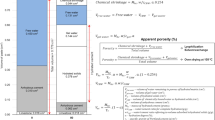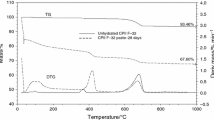Abstract
Cement hydration occurs according to a sequence of reactions whose products have a direct influence on the working properties of concretes and mortars during their use. The understanding of the evolution of its formation is quite simple and focused on monitoring the identification of resulting hydrate formed and their corresponding quantification by content of bound water after hydration stoppage and drying at certain set periods of time. Among the more common techniques are the methods of direct drying, where free water is eliminated by evaporation or sublimation or by replacing the existing water with organic solvents and then evaporating them. The existing doubts about the effect of these treatments in the change of the hydrate composition make it difficult to obtain an accurate determination. This work aimed to assess the impact of the stoppage of the hydration reaction of CPV (cement Portland type V from Brazilian market) in the results obtained by freeze-drying or immersion in an organic solvent as isopropanol or acetone, followed by substitution for diethyl ether. This last step is aimed at dispensing with the need for elevated temperatures or other aggressive solvent elimination methods such as evaporation under low pressure. The hydration was monitored at the previously set periods, and the hydrated products were analyzed by thermogravimetry and X-ray diffractometry. The results indicate that the technique of immersion on isopropanol and drying with diethyl ether is the most suitable one, as it does not affect the hydrated product composition.









Similar content being viewed by others
Notes
The structural formula of the cited organic solvents is: methanol (CH3OH), acetone ((CH3)2CO), ethanol (CH3CH2OH), and isopropanol ((CH3)2CHOH).
\(({\text{CH}}_{3} )_{2} {\text{CO}} + {\text{HCH}}_{2} {\text{COCH}}_{3} \mathop {\longrightarrow} \limits_{{{\text{Ca}}\left( {\text{OH}} \right)_{2} }} {\text{CH}}_{3} {\text{OHC}} {-} {\text{CH}}_{2} {\text{COCH}}_{3} \mathop {\longrightarrow} \limits_{{ {-} {\text{H}}_{2} {\text{O}}}} {\text{CH}}_{3} {\text{C}} {-} {\text{CHCOCH}}_{3}\)
The structural formula of diethyl ether is CH3CH2–O–CH2CH3.
Nomenclature related to a binder without additions commercialized in Brazil.
In cement chemistry the chemical species are represented by: C—CaO; H—H2O; S—SiO2; A—Al2O3; \(\bar{S}\)—SO3; \(\bar{C}\)—CO3.
References
Muller ACA, Scrivener KL, Gajewicz AM, McDonald PJ. Densification of C–S–H measured by 1H NMR relaxometry. J Phys Chem C. 2013. https://doi.org/10.1021/jp3102964.
Ridi F, Luciani P, Fratini E, Baglioni P. Water confined in cement pastes as a probe of cement microstructure evolution. J Phys Chem B. 2009. https://doi.org/10.1021/jp808754t.
Scrivener KL, Juilland P, Monteiro PJM. Advances in understanding hydration of Portland cement. Cem Concr Res. 2015. https://doi.org/10.1016/j.cemconres.2015.05.025.
Zhang J, Scherer GW. Comparison of methods for arresting hydration of cement. Cem Concr Res. 2011. https://doi.org/10.1016/j.cemconres.2011.06.003.
Day RL, Marsh BK. Measurement of porosity in blended cement pastes. Cem Concr Res. 1988. https://doi.org/10.1016/0008-8846(88)90122-6.
Kocaba V. Development and evaluation of methods to follow microstructural development of cementitious systems including slags. Thesis (Phd). Lausanne: École Polytechniche Federale de Lausanne (EPFL); 2009.
Collier NC, Sharp JH, Milestone NB, Hill J, Godfrey IH. The influence of water removal techniques on the composition and microstructure of hardened cement pastes. Cem Concr Res. 2008. https://doi.org/10.1016/j.cemconres.2008.02.012.
Konecny L, Naqvi SJ. The effect of different drying techniques on the pore size distribution of blended cement mortars. Cem Concr Res. 1993. https://doi.org/10.1016/0008-8846(93)90183-A.
Feldman RF. Diffusion measurements in cement paste by water replacement using Propan-2-OL. Cem Concr Res. 1987. https://doi.org/10.1016/0008-8846(87)90133-5.
Snoeck D, Velasco LF, Mignon A, Van Vlierberghe S, Dubruel P, Lodewyckx P, De Belie N. The influence of different drying techniques on the water sorption properties of cement-based materials. Cem Concr Res. 2014. https://doi.org/10.1016/j.cemconres.2014.06.009.
Makar JM, Sato T. The effect of drying method on ordinary Portland cement surfaces during the early stages of hydration. Mater Struct. 2012. https://doi.org/10.1617/s11527-012-9878-2.
De Weerdt K, Haha MB, Le Saout G, Kjellsen KO, Justnes H, Lothenbach B. Hydration mechanisms of ternary Portland cements containing limestone powder and fly ash. Cem Concr Res. 2011. https://doi.org/10.1016/j.cemconres.2010.11.014.
Gallé C. Effect of drying on cement-based materials pore structure as identified by mercury intrusion porosimetry: a comparative study between oven-, vacuum-, and freeze-drying. Cem Concr Res. 2001. https://doi.org/10.1016/S0008-8846(01)00594-4.
Scrivener K, Snellings R, Lothenbach B. A practical guide to microstructural analysis of cementitious materials. London: CRC Press; 2016.
Korpa A, Trettin R. The influence of different drying methods on cement paste microstructures as reflected by gas adsorption: comparison between freeze-drying (F-drying), D-drying, P-drying and oven-drying methods. Cem Concr Res. 2006. https://doi.org/10.1016/j.cemconres.2005.11.021.
L’Hôpital E, Lothenbach B, Kulik DA, Scrivener K. Influence of calcium to silica ratio on aluminium uptake in calcium silicate hydrate. Cem Concr Res. 2016. https://doi.org/10.1016/j.cemconres.2016.01.014.
Zhang L, Glasser FP. Critical examination of drying damage to cement pastes. Adv Cem Res. 2000. https://doi.org/10.1680/adcr.2000.12.2.79.
Rößler C, Eberhardt A, Kučerová H, Möser B. Influence of hydration on the fluidity of normal Portland cement pastes. Cem Concr Res. 2008. https://doi.org/10.1016/j.cemconres.2008.03.003.
Thomas MDA. The suitability of solvent exchange techniques for studying the pore structure of hardened cement paste. Adv Cem Res. 1989. https://doi.org/10.1680/adcr.1989.2.5.29.
Day RL. Reactions between methanol and Portland cement paste. Cem Concr Res. 1981. https://doi.org/10.1016/0008-8846(81)90106-X.
Taylor HFW, Turner AB. Reactions of tricalcium silicate paste with organic liquids. Cem Concr Res. 1987. https://doi.org/10.1016/0008-8846(87)90134-7.
Mitchell LD, Margeson JC. The effects of solvents on C–S–H as determined by thermal analysis. J Therm Anal Calorim. 2006. https://doi.org/10.1007/s10973-006-7712-1.
Beaudoin JJ, Gu P, Marchand J, Tamtsia B, Myers RE, Liu Z. Solvent replacement studies of hydrated portland cement systems: the role of calcium hydroxide. Adv Cem Based Mater. 1998. https://doi.org/10.1016/S1065-7355(98)00008-X.
Khoshnazar R. Solvent exchange in sulphoaluminate phases. Part I: ettringite. Adv Cem Res. 2013. https://doi.org/10.1680/adcr.12.00042.
Khoshnazar R, Beaudoin J, Raki L, Alizadeh R. Solvent exchange in sulfoaluminate phases. Part II: monosulfate. Adv Cem Res. 2013. https://doi.org/10.1680/adcr.12.00055.
Beaudoin JJ, Tamtsia B, Marchand J, Myers HR. Solvent exchange in partially saturated and saturated microporous systems: length change anomalies. Cem Concr Res. 2000. https://doi.org/10.1016/S0008-8846(99)00260-4.
Parrott LJ, Hansen W, Berger RL. Effect of first drying upon the pore structure of hydrated alite paste. Cem Concr Res. 1980. https://doi.org/10.1016/0008-8846(80)90028-9.
Beaudoin JJ. Effect of drying methods on microstructural changes in hardened cement paste: an a.c. impedance spectroscopy evaluation. J Adv Concr Technol. 2004;2:113–20.
Berodier E, Scrivener K. Evolution of pore structure in blended systems. Cem Concr Res. 2015. https://doi.org/10.1016/j.cemconres.2015.02.025.
Litvan GG. Variability of the nitrogen surface area of hydrated cement paste. Cem Concr Res. 1976. https://doi.org/10.1016/0008-8846(76)90058-2.
Deschner F, Winnefeld F, Lothenbach B, Seufert S, Schwesig P, Dittrich S, Goetz-Neunhoeffer F, Neubauer J. Hydration of Portland cement with high replacement by siliceous fly ash. Cem Concr Res. 2012. https://doi.org/10.1016/j.cemconres.2012.06.009.
Schöler A, Lothenbach B, Winnefeld F, Zajac M. Hydration of quaternary Portland cement blends containing blast-furnace slag, siliceous fly ash and limestone powder. Cem Concr Compos. 2015. https://doi.org/10.1016/j.cemconcomp.2014.10.001.
Brunauer S, Emmett PH, Teller E. Adsorption of gases in multimolecular layers. J Am Chem Soc. 1938. https://doi.org/10.1021/ja01269a023.
Mantellato S, Palacios M, Flatt RJ. Reliable specific surface area measurements on anhydrous cements. Cem Concr Res. 2015. https://doi.org/10.1016/j.cemconres.2014.10.009.
Mantellato S, Palacios M, Flatt RJ. Impact of sample preparation on the specific surface area of synthetic ettringite. Cem Concr Res. 2016. https://doi.org/10.1016/j.cemconres.2016.04.005.
Kalliopi A. Pore structure of cement-based materials. London: Taylor & Francis; 2006.
Rietveld HM. A profile refinement method for nuclear and magnetic structures. J Appl Crystallogr. 1969. https://doi.org/10.1107/S0021889869006558.
Yates D, Moore D, McGabe G. The practice of statistics. 1st ed. New York: W H Freeman; 1999.
Bullard JW, Jennings HM, Livingston RA, Nonat A, Scherer GW, Schweitzer JS, Scrivener KL, Thomas JJ. Mechanisms of cement hydration. Cem Concr Res. 2011. https://doi.org/10.1016/j.cemconres.2010.09.011.
Gartner E, Young JF, Damidot D, Jawed I. Hydration of Portland cement. London: Spon Press; 2002. p. 83–4.
Juilland P, Gallucci E, Flatt R, Scrivener K. Dissolution theory applied to the induction period in alite hydration. Cem Concr Res. 2010. https://doi.org/10.1016/j.cemconres.2010.01.012.
Garrault S, Nonat A. Hydrated layer formation on tricalcium and dicalcium silicate surfaces: experimental study and numerical simulations. Langmuir. 2001. https://doi.org/10.1021/la011201z.
Minard H, Garrault S, Regnaud L, Nonat A. Mechanisms and parameters controlling the tricalcium aluminate reactivity in the presence of gypsum. Cem Concr Res. 2007. https://doi.org/10.1016/j.cemconres.2007.06.001.
Baquerizo LG, Matschei T, Scrivener KL, Saeidpour M, Wadsö L. Hydration states of AFm cement phases. Cem Concr Res. 2015. https://doi.org/10.1016/j.cemconres.2015.02.011.
Pöllmann H. Syntheses, properties and solid solution of ternary lamellar calcium aluminate hydroxi salts (AFm-phases) containing SO4 2−, CO3 2− and OH−. Neues Jahrb Für Mineral – Abh. 2006. https://doi.org/10.1127/0077-7757/2006/0042.
Matschei T, Lothenbach B, Glasser FP. Thermodynamic properties of Portland cement hydrates in the system CaO–Al2O3–SiO2–CaSO4–CaCO3–H2O. Cem Concr Res. 2007. https://doi.org/10.1016/j.cemconres.2007.06.002.
Ipavec A, Gabrovšek R, Vuk T, Kaučič V, Maček J, Meden A. Carboaluminate phases formation during the hydration of calcite-containing Portland cement. J Am Ceram Soc. 2011. https://doi.org/10.1111/j.1551-2916.2010.04201.x.
Hartman MR, Brady SK, Berliner R, Conradi MS. The evolution of structural changes in ettringite during thermal decomposition. J Solid State Chem. 2006. https://doi.org/10.1016/j.jssc.2006.01.038.
Puerta-Falla G, Balonis M, Saout GL, Kumar A, Rivera M, Falzone G, Neithalath N, Sant G. The influence of slightly and highly soluble carbonate salts on phase relations in hydrated calcium aluminate cements. J Mater Sci. 2016. https://doi.org/10.1007/s10853-016-9912-9.
Yuan CZ, Min ZW, Jiang L. Determination of preferred orientation degree of portlandite by using rocking curve of diffraction line. Mater Struct. 1988. https://doi.org/10.1007/BF02472158.
Gogonea V, Bãleanu-Gogonea C, Osawa E. Solvent hard sphere diameter from van der Waals volume A statistical analysis of computed and solubility determined solvent diameters. J Mol Struct Theochem. 1998. https://doi.org/10.1016/S0166-1280(97)00409-0.
Gallucci E, Scrivener K. Crystallisation of calcium hydroxide in early age model and ordinary cementitious systems. Cem Concr Res. 2007. https://doi.org/10.1016/j.cemconres.2007.01.001.
Taylor HFW. Cement chemistry. 1st ed. London: Thomas Telford; 1997.
Kriegel R, Hellrug R, Dimmig A. Qualitative and quantitative analysis of selected organic additives in hardened concrete by thermal analysis and infrared spectroscopy. In: 11th international congress on the chemistry of cement, Durban, South Africa; 2013. p. 171–180.
Jenni A, Holzer L, Zurbriggen R, Herwegh M. Influence of polymers on microstructure and adhesive strength of cementitious tile adhesive mortars. Cem Concr Res. 2005. https://doi.org/10.1016/j.cemconres.2004.06.039.
Pane I, Hansen W. Investigation of blended cement hydration by isothermal calorimetry and thermal analysis. Cem Concr Res. 2005. https://doi.org/10.1016/j.cemconres.2004.10.027.
Acknowledgements
The authors wish to acknowledge and thank the Laboratory of Microstructure and Material Eco-efficiency—LME, CNPq—National Council for Scientific and Technological Development (research grant—155357/2016-6) and to FAPESP (Project 2014/50948-3—INCT CEMtec—Tecnologias Cimentícias Ecoeficientes Avançadas), for their financial support to this research work. They also want to thank their colleague Renan Piccolo Salvador for his valuable contribution in reviewing this work.
Author information
Authors and Affiliations
Corresponding author
Rights and permissions
About this article
Cite this article
Maciel, M.H., Soares, G.S., Romano, R.C.d.O. et al. Monitoring of Portland cement chemical reaction and quantification of the hydrated products by XRD and TG in function of the stoppage hydration technique. J Therm Anal Calorim 136, 1269–1284 (2019). https://doi.org/10.1007/s10973-018-7734-5
Received:
Accepted:
Published:
Issue Date:
DOI: https://doi.org/10.1007/s10973-018-7734-5




